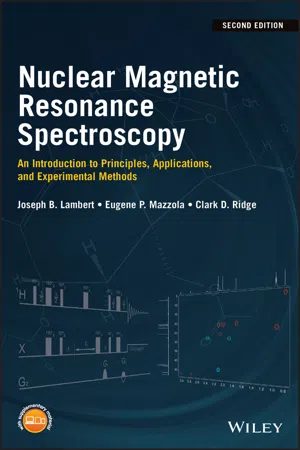
Nuclear Magnetic Resonance Spectroscopy
An Introduction to Principles, Applications, and Experimental Methods
- English
- PDF
- Available on iOS & Android
Nuclear Magnetic Resonance Spectroscopy
An Introduction to Principles, Applications, and Experimental Methods
About this book
Combines clear and concise discussions of key NMR concepts with succinct and illustrative examples
Designed to cover a full course in Nuclear Magnetic Resonance (NMR) Spectroscopy, this text offers complete coverage of classic (one-dimensional) NMR as well as up-to-date coverage of two-dimensional NMR and other modern methods. It contains practical advice, theory, illustrated applications, and classroom-tested problems; looks at such important ideas as relaxation, NOEs, phase cycling, and processing parameters; and provides brief, yet fully comprehensible, examples. It also uniquely lists all of the general parameters for many experiments including mixing times, number of scans, relaxation times, and more.
Nuclear Magnetic Resonance Spectroscopy: An Introduction to Principles, Applications, and Experimental Methods, 2nd Edition begins by introducing readers to NMR spectroscopy - an analytical technique used in modern chemistry, biochemistry, and biology that allows identification and characterization of organic, and some inorganic, compounds. It offers chapters covering: Experimental Methods; The Chemical Shift; The Coupling Constant; Further Topics in One-Dimensional NMR Spectroscopy; Two-Dimensional NMR Spectroscopy; Advanced Experimental Methods; and Structural Elucidation.
- Features classical analysis of chemical shifts and coupling constants for both protons and other nuclei, as well as modern multi?pulse and multi-dimensional methods
- Contains experimental procedures and practical advice relative to the execution of NMR experiments
- Includes a chapter-long, worked-out problem that illustrates the application of nearly all current methods
- Offers appendices containing the theoretical basis of NMR, including the most modern approach that uses product operators and coherence-level diagrams
By offering a balance between volumes aimed at NMR specialists and the structure-determination-only books that focus on synthetic organic chemists, Nuclear Magnetic Resonance Spectroscopy: An Introduction to Principles, Applications, and Experimental Methods, 2nd Edition is an excellent text for students and post-graduate students working in analytical and bio-sciences, as well as scientists who use NMR spectroscopy as a primary tool in their work.
Frequently asked questions
- Essential is ideal for learners and professionals who enjoy exploring a wide range of subjects. Access the Essential Library with 800,000+ trusted titles and best-sellers across business, personal growth, and the humanities. Includes unlimited reading time and Standard Read Aloud voice.
- Complete: Perfect for advanced learners and researchers needing full, unrestricted access. Unlock 1.4M+ books across hundreds of subjects, including academic and specialized titles. The Complete Plan also includes advanced features like Premium Read Aloud and Research Assistant.
Please note we cannot support devices running on iOS 13 and Android 7 or earlier. Learn more about using the app.
Information
Table of contents
- Cover
- Title Page
- Copyright
- Contents
- Preface to First Edition
- Preface to Second Edition
- Solutions
- Symbols
- Abbreviations
- Chapter 1 Introduction
- Chapter 2 Introductory Experimental Methods
- Chapter 3 The Chemical Shift
- Chapter 4 The Coupling Constant
- Chapter 5 Further Topics in One-Dimensional NMR Spectroscopy
- Chapter 6 Two-Dimensional NMR Spectroscopy
- Chapter 7 Advanced Experimental Methods
- Chapter 8 Structural Elucidation: Two Methods
- Appendix A Derivation of the NMR Equation
- Appendix B The Bloch Equations
- Appendix C Quantum Mechanical Treatment of the Two-Spin System
- Appendix D Analysis of Second-Order, Three- and Four-Spin Systems by Inspection
- Appendix E Relaxation
- Appendix F Product-Operator Formalism and Coherence-Level Diagrams
- Appendix G Stereochemical Considerations
- Index
- EULA